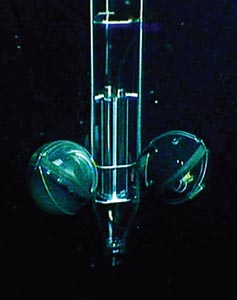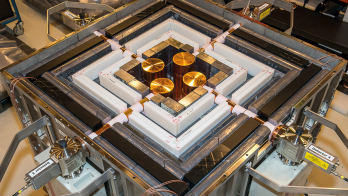After many years of tests, the ANTARES neutrino detector deployed in the Mediterranean Sea is using its first full detector line to register the tracks of cosmic-ray muons.
On 14 February 2006 the first fully instrumented ANTARES detector line was deployed and placed at a predetermined place on the bottom of the Mediterranean Sea, about 40 km off the coast of Toulon, and at a depth of 2500 m. On 2 March, a remote-controlled submarine connected the line to the junction box, the terminal at the end of the 40 km telecommunications cable that leads to the shore station at La Seyne-sur-Mer. On the same day the line recorded the first cosmic-ray tracks. This is the first of 12 lines to be deployed over the next 18 months, after many years of tests that have investigated conditions at the detector site and parts of the detector set-up. An instrumentation line has been taking data smoothly since April 2005 (Aguilar et al. 2006).
ANTARES is one of only a few detectors employing natural seawater or ice as the detector medium to search for neutrinos of extraterrestrial origin. These neutrinos may have been produced in high-energy events in the cosmos, travelling towards us undisturbed by intervening matter or magnetic fields. If their direction can be determined then their origin in the universe can be identified. High-energy neutrinos could also be indicators for certain types of dark matter.
The neutrino is weakly interacting and this sets the scale of the detectors. Only truly gargantuan sizes allow the detection of neutrinos with sufficient sensitivity to be useful. It was an idea of Moissey Markov in 1960 that gave impetus to the possibility of neutrino astronomy. He reasoned that if one concentrated on muon-neutrinos through the detection of a muon produced in a charged-current interaction, then the large range of the muon in matter would allow for large effective volumes. The direction of the muon is closely related to the direction of the neutrino, and if the detection medium is water or transparent ice then the muon can be tracked through its emission of Cherenkov radiation.
For ANTARES, the Mediterranean Sea and the rock below the seabed provide the interaction volume, and the water provides the detection medium. Because of its large scattering length for Cherenkov light, the seawater allows excellent timing and, consequently, good directional accuracy can be obtained. The Mediterranean was chosen because it is in the Northern Hemisphere and provides complementary sky coverage, including the centre of our galaxy, to the AMANDA and IceCube detectors that are operating in the Antarctic ice.
The overall detector consists of storeys suspended at intervals of 14.5 m along a 500 m vertical cable, which is anchored to the sea floor and held vertical by a buoy at the top of the cable. The storeys begin at 100 m above the seabed and there are 25 such storeys on a line. Placing more of these cables at distances of 70 m increases the volume of the detector.

Figure 1 shows a storey in situ in the sea, with the glass pressure spheres housing the 25 cm diameter photomultiplier tubes (PMTs) that are used to detect the Cherenkov light. The PMTs point downwards at an angle of 45° with respect to the vertical. Two are clearly visible, whereas the third is hidden behind the titanium cylinder that contains the electronics for the readout and control of the storey, and an electronic compass, plus a tilt meter. A hydrophone, used for acoustic positioning, is located at the bottom of the storey.
The PMTs operate at a threshold of 0.4 photoelectrons. All the data produced by the tubes are transferred via an optical cable to the shore, where a farm of computers processes the data to extract interesting events. Because of radioactive potassium present in the seawater, each PMT has a base rate of about 60 kHz; bioluminescent life in the seawater may increase this rate. It is the task of the software running on the computer farm to recognize the presence of a muon track among the background hits. At present the software is able to perform this task up to about five times the base rate. However, conditions at the bottom of the sea can vary significantly. There was a period of relative calm just after deployment, followed by two months of high bioluminescent activity, making data-taking difficult; now the background activity has subsided and normal data-taking has resumed.
The present software selects slices in time and searches for the passage of muons through their time patterns in the PMTs along the string. The final stage of the process is a χ2 minimization fit to the height versus time pattern. The reconstructed data set is dominated by down-going muons originating from high-energy cosmic-ray showers in the atmosphere. The main signature of a neutrino-induced muon is that it originates from below, in which case the Earth acts as a very effective filter against the directly produced muons.

Figure 2 shows two examples of reconstructed tracks from data from the first ANTARES line. Figure 2a shows a vertical muon track, where the signal propagates down the line with the velocity of the muon, and figure 2b shows a slightly more inclined track identified by the change in the signal’s vertical propagation velocity, before and after the closest approach. So far several thousand tracks of down-going muons have been reconstructed and a few candidates for up-going muons have also been observed.
The ANTARES Collaboration is now in full swing analysing the data coming from this first detector line. The experience of the first line shows that we are on track towards a full neutrino telescope in the Mediterranean and we look forward to several years of data-taking.
Further reading
J A Aguilar et al. 2006 http://arxiv.org/abs/astro-ph/0606229.
For further information about ANTARES see http://antares.in2p3.fr.








